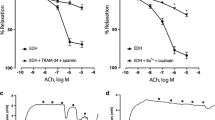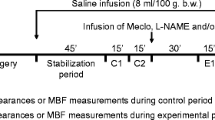Abstract
The aim of this study was to evaluate the roles of nitric oxide (NO) and prostanoids in vasodilation to histamine in the preconstricted isolated perfused rat kidney. Kidneys were excised from Hypnorm/Hypnovelanaesthetised Wistar rats and perfused at constant flowin vitro. Renal perfusion pressure was elevated similarly with methoxamine (3 µM) or modified Krebs Henseleit solution containing high KCl (30 mM) and vasodilation to histamine (10, 30 nmol) and papaverine (30, 100 nmol) was then examined before and during perfusion with the NO synthase inhibitor, NG-nitro-L-arginine methyl ester (L-NAME, 0.3 mM) or the cyclo-oxygenase inhibitor, indomethacin (10 µM). Furthermore, the vasodilator response to 30 nmol histamine was examined in the presence of the H2 receptor antagonist, ranitidine (0.1–10 µM). Vasodilation to histamine (10, 30 nmol) was found to be unaffected by L-NAME (0.3 mM) or indomethacin (10 µM), while ranitidine (0.1–10 µM) antagonised vasodilation to 30 nmol histamine with an estimated pA2 of 6.67. Vasodilation to histamine in the isolated perfused rat kidney is therefore probably independent of NO and prostanoids and mediated by H2 receptors.
Similar content being viewed by others
References
Conger JD. Vascular abnormalities in the maintenance of acute renal failure. Circ Shock 1983;11:235–44.
Conger JD, Robinette JB, Hammond WS. Differences in vascular reactivity in models of ischaemic acute renal failure. Kidney Int 1991;39:1087–97.
Conger JD, Robinette JB, Schrier RW. Smooth muscle calcium and endothelium-derived relaxing factor in the abnormal vascular responses of acute renal failure. J Clin Invest 1988;82:532–7.
Matthys E, Patton KMK, Osgood RW, Venkatachalam MA, Stein JH. Alterations in vascular function and morphology in acute ischaemic failure. Kidney Int 1983;23:717–24.
Furchgott RF, Zawadzki JV. The obligatory role of endothelial cells in the relaxation of arterial smooth muscle by acetylcholine. Nature 1980;288:373–6.
Bhardwaj R, Moore PK. Endothelium-derived relaxing factor and the effects of acetylcholine and histamine on resistance blood vessels. Br J Pharmacol 1988;95:835–43.
Palmer RMJ, Ferrige AG, Moncada S. Nitric oxide release accounts for the biologic activity of endothelium-derived relaxing factor. Nature 1987;333:524–6.
Palmer RMJ, Rees DD, Ashton DS, Moncada S. L-arginine is the physiological precursor of the formation of nitric oxide in endothelium-dependent relaxation. Biochem Biophys Res Comm 1988;153:1251–6.
Rees DD, Palmer RMJ, Schulz R, Hodson HF, Moncada S. Characterisation of three inhibitors of nitric-oxide synthase in vitro and in vivo. Br J Pharmacol 1990;101:746–52.
Baenziger NL, Fogerty FJ, Mertz LF, Chernuta LF. Regulation of histamine-mediated prostacyclin synthesis in cultured human vascular endothelial cells. Cell 1981;24:915–23.
McIntyre TM, Zimmerman GA, Satoh K, Prescott M. Cultured endothelial cells synthesize both platelet-activating factor and prostacyclin in response to histamine, bradykinin, and adenosine triphosphate. J Clin Invest 1985;76:271–9.
Tenner TE, McCully JP. Characterisation of H2-receptor mediated relaxation in rabbit aortic strips. Eur J Pharmacol 1981;73:293–300.
Casteels R, Suzuki H. The effect of histamine on the smooth muscle cells of the ear artery of the rabbit. Pflügers Arch 1980;387:17–25.
Ercan ZS, Türker RK. Histamine receptors in the isolated rat stomach fundus and rabbit aortic strips. Pharmacol 1977;15:118–26.
Mirbahar KB, Eyre P. Occurrence of inhibitory histamine H2-receptors in bovine pulmonary arteries. Eur J Pharmacol 1982;77:331–4.
Nishiitsutsuji-Uwo JM, Ross BD, Krebs HA. Metabolic activities of the isolated perfused rat kidney. Biochem J 1967;103:852–62.
Schurek HF, Brecht JP, Lohfert H, Hierholzer K. The basic requirements for the function of the isolated cell free perfused rat kidney. Pflügers Arch 1975;354:349–65.
Linas SL. Mechanism of hyperreninaemia in the potassium-depleted rat. J Clin Invest 1981;68:347–55.
Burton GA, MacNeil S, De Jonge A, Haylor J. cGMP release and vasodilation induced by EDRF and ANF in the isolated perfused kidney of the rat. Br J Pharmacol 1990;99:364–8.
Lazareno S, Birdsall NJM. Estimation of competitive antagonist affinity from functional inhibition curves using the Gaddum, Schild and Cheng-Prusoff equations. Br J Pharmacol 1993;109:1110–9.
Lazareno S, Birdsall NJM. Estimation of antagonist K b from inhibition curves in functional experiments: alternatives to the Cheng-Prusoff equation. Trends Pharmacol Sci 1993;14:237–9.
Balfagon G, Galvan R, Marco EJ. Mechanism of the indirect adrenergic effect of histamine in cat cerebral arteries. J Pharm Pharmacol 1984;36:248–52.
Adeagbo AS, Malik KU. Endothelium-dependent and BR34915-induced vasodilation in rat isolated perfused mesenteric arteries: role of G-proteins, potassium and calcium currents. Br J Pharmacol 1990;100:427–34.
Molleman A, Hoiting B, Duin M, van den Anker J, Melemans A, Den Hertog A. Potassium channels regulated by inositol 1,3,4,5-tetrakisphosphate and internal calcium in DDTI MF-2 smooth muscle cells. J Biol Chem 1991;266:5658–63.
Neliat G, Masson F, Gargouil YM. Modulation of the spontaneous transient outward currents by histamine in single vascular smooth muscle cells. Pflugers Arch 1989;414:S186–7.
Welch WJ, Wilcox CS, Aisaka K, Gross SS, Griffith OW, Fontoura BMA, Maack T, Levi R. Nitric oxide synthesis from L-arginine modulates renal vascular resistance in isolated perfused and intact rat kidneys. J Cardiovasc Pharmacol 1991;17(S3):S165–8.
Radermacher J, Fürstermann U, Frülich C. Endotheliumderived relaxing factor influences renal vascular resistance. Am J Physiol 1992;259:F9–17.
Tolins JP, Palmer RMJ, Moncada S, Raij L. Role of endothelium-derived relaxing factor in regulation of renal haemodynamic responses. Am J Physiol 1990;258:H665–2.
Gulbins E, Hoffend J, Zou AP, Dietrich MS, Schlottmann K, Cavarape A, Steinhausen M. Endothelin and endotheliumderived relaxing factor control of basal renovascular tone in hydronephrotic rat kidneys. J Physiol 1993;469:571–82.
Hoffend J, Cavarape A, Endlich K, Steinhausen M. Influence of endothelium-derived relaxing factor on renal microvessels and pressure-dependent vasodilation. Am J Physiol 1993;265:F285–92.
Farhat MY, Ramwell PW, Thomas G. Endothelium-mediated effects of N-substituted arginines on the isolated perfused rat kidney. J Pharmac Exp Therap 1990;255:473–7.
Reinhardt D, Ritter E. Hypothermia-induced potentiation of histamine H2-receptor-mediated relaxation and cAMP increases in the isolated mesenteric artery of the rabbit. Agents Actions 1979;9:9–14.
Cavanagh RL, Usakewicz JJ, Buyniski JP. A comparison of some of the pharmacological properties of etintidine, a new histamine H2-receptor antagonist, with those of cimetidine, ranitidine and tiotidine. J Pharmac Exp Therap 1983;224: 171–9.
Akar F, Ercan ZS, Türker RK. A marked H1-receptor-mediated vasodilator effect of histamine in the isolated perfused rat-heart. Eur J Pharmacol 1984;97:265–9.
Moritoki H, Hosoki E, Ishida Y. Age-related decrease in endothelium-dependent dilator response to histamine in rat mesenteric artery. Eur J Pharmacol 1986;126:61–7.
van de Voorde J, Leusen I. Influence of prostaglandin-synthesis inhibitors on carbachol- and histamine-induced vasodilation in perfused rat hindquarters. Plügers Arch 1983;397:290–4.
Arrang JM, Garbag M, Lancelot JC, Lecomte JM, Pollard H, Robba M, Schunack W, Schwartz JC. Highly potent and selective ligands for histamine H3-receptors. Nature 1987;327:117–22.
Author information
Authors and Affiliations
Rights and permissions
About this article
Cite this article
Laight, D.W., Woodward, B. & Waterfall, J.F. Renal vasodilation to histaminein vitro: Roles of nitric oxide, cyclo-oxygenase products and H2 receptors. Inflamm Res 44, 116–120 (1995). https://doi.org/10.1007/BF01782021
Received:
Revised:
Accepted:
Issue Date:
DOI: https://doi.org/10.1007/BF01782021




